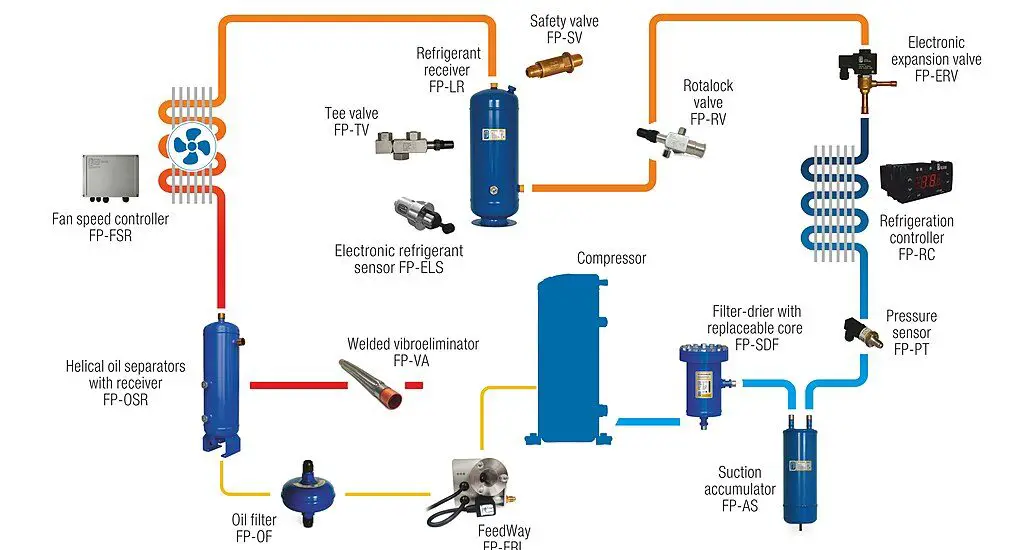If you are curious about “how does an expansion valve work?” we’ll unravel the complexities in this article. Let’s begin, shall we?

The Fundamentals of the Expansion Valve
The expansion valve might appear as a modest component, but its function is paramount in HVAC systems. It’s the gatekeeper, determining the volume of refrigerant that enters the evaporator. As the refrigerant passes through the valve, its pressure drops, which facilitates the next stage of the cooling process in the evaporator coil.
How Does an Expansion Valve Work
The expansion valve often likened to a traffic cop, directs the flow of refrigerant within the HVAC system. Just as a traffic officer ensures vehicles move smoothly without congestion, the expansion valve maintains the optimal flow of refrigerant. Let’s break down its operation into simpler steps for better clarity:
Sensing Bulb: Imagine the sensing bulb as the eyes and ears of the expansion valve. It’s strategically placed on the evaporator’s outlet and is filled with a special refrigerant. By sensing the temperature of the refrigerant gas as it exits the evaporator, it serves as a feedback mechanism. This feedback tells the valve if more or less refrigerant is needed.
Pressure Adjustments: As we all know, temperature changes can cause substances to expand or contract. The refrigerant inside the sensing bulb is no exception. When it’s warm, it expands, and when it’s cool, it contracts. This changing volume inside the bulb results in varying pressures. Think of it like blowing up a balloon: the more air (or in this case, refrigerant) inside, the greater the pressure.
Regulation Mechanism: Based on the pressure feedback from the sensing bulb, the expansion valve adjusts. If the bulb indicates things are getting too warm (high pressure), the valve opens wider to let in more cooling refrigerant. Conversely, if things are too cool (low pressure), it narrows its opening, reducing the refrigerant flow. It’s like adjusting a water tap based on the desired water flow.
Throttling Process: The valve doesn’t just open or close; it delicately adjusts to ensure the refrigerant undergoes a critical transformation. As the refrigerant passes through the narrowed valve, its pressure drops significantly. This drop is like squeezing a garden hose, making the outflow a fine mist. In the case of the refrigerant, this “squeezing” changes it from a high-pressure liquid to a low-pressure mix of liquid and gas, preparing it for efficient cooling in the evaporator.
Maintaining Equilibrium: The ultimate goal of the expansion valve is balance. It’s always striving to ensure that the evaporator has just the right amount of refrigerant for optimal cooling. Too much or too little can be problematic, so it continually adjusts to keep things just right.
Speaking of refrigerants, ensure that you always use one that’s safe like this ZeroR® AC Refrigerant on Amazon.
Check out these other related articles…
Expansion Valve in AC: Your Comprehensive Guide
Electronic Expansion Valve: Your Easy Guide
Expansion Valve Types: Your Comprehensive Guide
Expansion Valve in Refrigerator: Your Easy 101 Guide
Expansion Valve Function: Easy 101 Guide
Shedding Light on the Varieties: Thermostatic vs. Thermal Expansion Valves
Upon investigating how an expansion valve functions, you’ll inevitably stumble upon terms like thermostatic expansion valve and thermal expansion valve. At their core, both valves maintain the same primary function – to control refrigerant flow. However, the methods they employ vary. A thermostatic expansion valve uses a filled bulb to respond to temperature changes, while a thermal expansion valve directly reacts to temperature shifts without the mediation of a sensing bulb.
